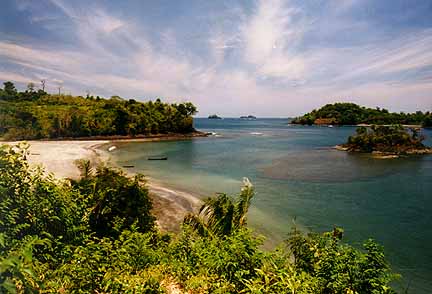- Bunaka
:"this article is about the island; for the
sleeper goby genus, see "Bunaka"Infobox Islands
name = Bunaka
image caption = The Eastern Beach of Bunaka
native name =
native name link =
location =South East Asia
coordinates= coord|7|49|S|121|6|E|type:isle
archipelago =Derawan Islands
total islands =
major islands =
area = 348 km²
highest mount = Mount Kalabali
elevation = 560 m
country = Indonesia
country admin divisions title = Province
country admin divisions =East Kalimantan
country largest city =
country largest city population =
population = 6,750
population as of = 2005
density = 19/km²
ethnic groups =Bunaka island is a volcanic island part of the
Derawan Islands ,East Kalimantan ,Indonesia . It is part of the Pombato chain east of Kalimantan, and sustains a mainly fishing,shellfish gathering population of 6,750 as of 2005.The economy is mainly based upon the
fisheries and is completely dependent on mainlandIndonesia for food and other supplies. Bunaka is a small island of 348 km². Its significance is that it marks the boundary between the islands to the west, theEast Kalimantan province, and the region to the east that is mainly under the jurisdiction ofCentral Sulawesi .The island of Bunaka is mainly populated by the ethnic group, the
Balinese , who is said to have fished in the surrounding waters since the 9th century.Location
Bunaka lies within the chain of the Derawan Islands between the larger neighboring islands of Kakaban to the west and Tarimun to the east. Not only is the island famous for its heritage of fishing and
pearl collecting but also for the exotic, rare birds that make their nests on the island, particularly on Mount Kalabali, giant birds such as theJavanese Lapwing migrate annually to this island and generates much interest from foreign environmental scientists.History
Bunaka was not settled well into the 17th century, though fishing throughout the region had been going on for centuries prior. Bunaka was settled by a group of
Balinese fishermen andoyster gatherers until a permanent settlement formed. Bunaka is also mentioned in several Arab trading texts and records as a source for fresh water and fruit, which helped combatscurvy , an illness brought on by a lack ofVitamin C . During three centuries of Dutch influence, administration of the islands was generally ignored and the people were mostly exempt from the colonial taxes the Dutch imposed on the largerIndonesia n islands. In spring 1846, Captain Bradley, an English whaler setting out fromIndia toNew Zealand was forced to make anchor on the island for repairs of damages suffered on hisschooner from a seasonal spring storm. He and his crew were able to live upon the hospitality of the natives, which he called the males "Jerries" and the females "Juns", until help arrived from the ships of theDutch East India Company . This incident was mentioned in the 1847 publication of the Queen's Naval Journals, though the credit of the natives were greatly diminished. DuringWorld War II , and subsequent Japanese occupation, Bunaka was a frequent destination forJapan ese deep sea fishing vessels. A Japanese transport ship was sunk off the coast byGato class submarine USS Hake (SS-256) onJanuary 11 ,1944 . After independence, Bunaka was made part of the Kalimantan province, administered directly fromSamarinda , capital ofEast Kalimantan . Bunaka suffered heavily from the1997 East Asian financial crisis , and as a result a number of fishermen left the islands for better conditions during this period.Climate
Due to its location and extremely small size, Bunaka sometimes has harsh weather. At times, ships are unable to dock because of strong northwestern winds in winter. The climate is warm and humid, and heavily influenced by warm sea currents. Precipitation is high throughout most of the year (annual average - 1532 mm), with occasional typhoon during the summer due to dominating southernly winds. The water around the island is about 15 degrees Celsius in winter, when the water is coolest. It warms to about 35 degrees Celsius in August, at its peak.
ee also
*
Derawan Islands
*East Kalimantan
*Islands of Indonesia
Wikimedia Foundation. 2010.
